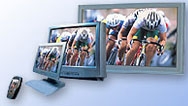Treat mobile TV like broadcast, not webcast, says Envivio's Ian Locke

If you build it, they will come, or so the cliché goes. But it's no guarantee that they won't leave as fast as they came.
That's the message of a 2007 Tellabs survey of mobile TV customers. Tellabs reports that former mobile TV viewers in Europe outnumber current viewers by nearly 20 percent. It's a statistic certain to strike fear in hearts throughout the mobile TV food chain.
But Ian Locke, Envivio VP of global communications, thinks he knows the reasons for those numbers and, more importantly, how to fix them.
"Quality, reliability and price were the main issues cited by users as the reason for dropping their subscription to mobile TV services. Quality of experience determines [mobile TV] success," he said. "Operators who address service shortcomings have seen massive results."
First and foremost to improving quality is the right frame of reference. "You have to treat [mobile TV] like a broadcast, not a webcast," Locke said. "Many of our competitors were people who specialized in IPTV. They're coming into the [three-screen] convergence world with that mindset. It's a mistake to think of it in the same terms."
If anyone knows about video quality, it's Envivio. The pioneering company contributed to the MPEG-4 standard and has an impressive record of industry “firsts,” including the launch, with RealNetworks, of the first MPEG-4 mobile TV encoder.
Now Envivio is promoting its software-based Convergence Series architecture that, combined with the company's multiprofile encoding technology, lets operators simultaneously deliver video streams at multiple bit rates and resolutions from a single input — for multiple mobile devices as well as broadcast and Internet TV.
The professional video industry's #1 source for news, trends and product and tech information. Sign up below.
For operators faced with an exploding number of services and devices, Envivio's technology lets them unify services on a single platform while delivering streams optimized for specific services and devices.
"The average operator has to deliver video to about 30 different handsets," Locke said. "Quality has to be good in a 2G network at 80kb/s and in a 3G network at 150 to 250kb/s. There's not one stream that can go to all these devices. You need to create content simultaneously in multiple streams. Multiprofile encoding is essential to having the best possible quality."
“The more [mobile TV] is like cable and satellite — despite what we've been told about the long tail — the more people will want to watch it," he said. "What people will pay for is to turn it on and watch."
For more information, visit www.tellabs.com/news/2008/nr021208.shtml.
